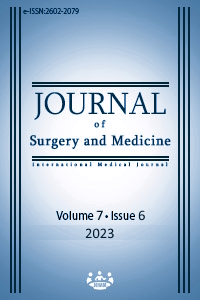A case of necrotizing fasciitis developing after cesarean section
Necrotizing fasciitis & cesarean section
Keywords:
cesarean section, necrotizing fasciitis, wound infection, CRPAbstract
Necrotizing fasciitis (NF) is a rare condition that is observed in obstetric and gynecological practices. It is a rapidly progressive and often fatal complication. Failure to obtain an early diagnosis and delay in initiating appropriate treatment can lead to significant morbidity and mortality. Our case was 25 years old, and she was in her first pregnancy. The patient had no systemic disease or history of previous surgery. Our patient’s baby was delivered by cesarean section with an indication of emergency fetal distress. During the cesarean section, it was observed that the amniotic fluid contained very dark meconium. No complications occurred during the cesarean section. Our patient presented with complaints of severe pain, bullae, and hyperemia at the level of the incision line one week later. In her vital findings, fever was 39.3 ºC, blood pressure was 90/60 mmHg, and heart rate was 110 /min. In laboratory tests, white blood cell count was 25,280 /mm3, C-reactive protein (CRP) was 431 mg/dL, and sedimentation was 100 mm/hour. On the ultrasonographic examination, air, significant edema, and thickening were observed in the incision line, skin, and subcutaneous tissues. On the computed tomography scan, thickening of the skin and subcutaneous tissues, fluid locations, and areas of air densities were observed over a wide area extending to the level of the thoracic 10th and 11th vertebrae superiorly and to the mons pubis inferiorly. Based on these findings, the patient was diagnosed with NF. After broad-spectrum antibiotic therapy and fluid-electrolyte support, extensive surgical debridement was performed under emergency conditions. Before applying the skin graft, vacuum-assisted wound closure was performed, and a very good response was obtained. The patient, whose pathology result was compatible with necrotizing fasciitis, was discharged on the 20th post-operative day. In this case, we aimed to present a case of NF after cesarean section.
Downloads
References
Lind Sarani B, Strong M, Pascual J, Schwab CW. Necrotizing fasciitis: current concepts and review of the literature. J Am Coll Surg. 2009;208(2):279-88. doi: 10.1016/j.jamcollsurg.2008.10.032 DOI: https://doi.org/10.1016/j.jamcollsurg.2008.10.032
Oelbrandt, B, Krasznai A, Bruyns T, et al. Surgical treatment of Fournier’s gangrene: use of cultured allogeneic keratinocytes. E J Plastic Surg. 2000;23:369–72. doi: 10.1007/s002380000188 DOI: https://doi.org/10.1007/s002380000188
Yamazhan T. Yumuşak dokunun nekrotizan enfeksiyonları. In: Gündeş S (Ed). Deri, yumuşak doku, eklem ve kemik enfeksiyonları. Ankara: Bilimsel Tıp Yayınevi; 2008: p. 277-285.
Ozgenel GY, Akin S, Kahveci R, Ozbek S, Ozcan M. Nekrotizan fasiitli 30 hastanin klinik değerlendirilmesi ve tedavi sonuçlari [Clinical evaluation and treatment results of 30 patients with necrotizing fasciitis]. Ulus Travma Acil Cerrahi Derg. 2004;10(2):110-4.
Light TD, Choi KC, Thomsen TA, et al. Long-term outcomes of patients with necrotizing fasciitis. J Burn Care Res. 2010;31(1):93-9. doi:10.1097/BCR.0b013e3181cb8cea DOI: https://doi.org/10.1097/BCR.0b013e3181cb8cea
Napolitano LM. Severe soft tissue infections. Infect Dis Clin North Am. 2009;23(3):571-91. doi: 10.1016/j.idc.2009.04.006 DOI: https://doi.org/10.1016/j.idc.2009.04.006
Simonart T. Group a beta-haemolytic streptococcal necrotising fasciitis: early diagnosis and clinical features. Dermatology. 2004;208(1):5-9. doi: 10.1159/000075038. DOI: https://doi.org/10.1159/000075038
Noor A, Krilov LR. Necrotizing Fasciitis. Pediatr Rev. 2021;42(10):573-5. doi: 10.1542/pir.2020-003871 DOI: https://doi.org/10.1542/pir.2020-003871
Downloads
- 406 1874
Published
Issue
Section
How to Cite
License
Copyright (c) 2023 İsa Kaplan
This work is licensed under a Creative Commons Attribution-NonCommercial-NoDerivatives 4.0 International License.
















